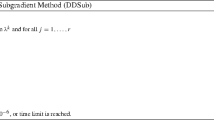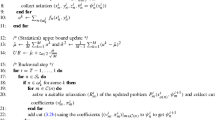Abstract
We introduce a variant of Multicut Decomposition Algorithms, called CuSMuDA (Cut Selection for Multicut Decomposition Algorithms), for solving multistage stochastic linear programs that incorporates a class of cut selection strategies to choose the most relevant cuts of the approximate recourse functions. This class contains Level 1 (Philpott et al. in J Comput Appl Math 290:196–208, 2015) and Limited Memory Level 1 (Guigues in Eur J Oper Res 258:47–57, 2017) cut selection strategies, initially introduced for respectively Stochastic Dual Dynamic Programming and Dual Dynamic Programming. We prove the almost sure convergence of the method in a finite number of iterations and obtain as a by-product the almost sure convergence in a finite number of iterations of Stochastic Dual Dynamic Programming combined with our class of cut selection strategies. We compare the performance of Multicut Decomposition Algorithms, Stochastic Dual Dynamic Programming, and their variants with cut selection (using Level 1 and Limited Memory Level 1) on several instances of a portfolio problem. On these experiments, in general, Stochastic Dual Dynamic Programming is quicker (i.e., satisfies the stopping criterion quicker) than Multicut Decomposition Algorithms and cut selection allows us to decrease the computational bulk with Limited Memory Level 1 being more efficient (sometimes much more) than Level 1.




Similar content being viewed by others
Notes
We considered in particular instances where M is less than the number \(2n+1\) of constraints of the subproblems to give MuDA a chance (according to Birge et al. (1996), cases where MuDA may be competitive with (single cut) SDDP satisfy this requirement).
We see in particular that the bounds for all algorithms are very close to each other at the last iteration and that, as expected, the lower bounds increase and the upper bounds tend to decrease along iterations. If we do not know the optimal value \({\mathcal {Q}}_{1}( x_{0})\), these observations (that we checked on all instances) are a good indication that all algorithms were correctly implemented.
References
Andersen ED, Andersen K (2013) The MOSEK optimization toolbox for MATLAB manual. Version 7
Asamov T, Powell W (2015) Regularized decomposition of high-dimensional multistage stochastic programs with markov uncertainty. arXiv:1505.02227
Birge J (1985) Decomposition and partitioning methods for multistage stochastic linear programs. Oper Res 33:989–1007
Birge J, Donohue CJ (2001) The abridged nested decomposition method for multistage stochastic linear programs with relatively complete recourse. Algo Oper Res 1:20–30
Birge J, Louveaux F (1988) A multicut algorithm for two-stage stochastic linear programs. Eur J Oper Res 34:384–392
Birge J, Louveaux F (1997) Introduction to stochastic programming. Springer, New York
Birge J, Donohue C, Holmes D, Svintsitski O (1996) A parallel implementation of the nested decomposition algorithm for multistage stochastic linear programs. Math Program 75:327–352
Chen Z, Powell W (1999) Convergent cutting-plane and partial-sampling algorithm for multistage stochastic linear programs with recourse. J Optim Theory Appl 102:497–524
Hindsberger M, Philpott AB (2001). Resa: A method for solving multi-stage stochastic linear programs. SPIX Stochastic Programming Symposium
Gaubert S, McEneaney W, Qu Z (2011) Curse of dimensionality reduction in maxplus based approximation methods: theoretical estimates and improved pruning algorithms. In: 50th IEEE conference on decision and control and european control conference (CDC-ECC), pp 1054–1061
Girardeau P, Leclere V, Philpott A (2015) On the convergence of decomposition methods for multistage stochastic convex programs. Math Oper Res 40:130–145
Guigues V (2014) SDDP for some interstage dependent risk-averse problems and application to hydro-thermal planning. Comput Optim Appl 57:167–203
Guigues V (2016) Convergence analysis of sampling-based decomposition methods for risk-averse multistage stochastic convex programs. SIAM J Optim 26:2468–2494
Guigues V (2017) Dual dynamic programing with cut selection: convergence proof and numerical experiments. Eur J Oper Res 258:47–57
Guigues V, Römisch W (2012) Sampling-based decomposition methods for multistage stochastic programs based on extended polyhedral risk measures. SIAM J Optim 22:286–312
Guigues V, Römisch W (2012) SDDP for multistage stochastic linear programs based on spectral risk measures. Oper Res Lett 40:313–318
Guigues V, Tekaya W, Lejeune M (2020) Regularized decomposition methods for deterministic and stochastic convex optimization and application to portfolio selection with direct transaction and market impact costs. Optim Eng 21:1133–1165
Kozmik V, Morton D (2015) Evaluating policies in risk-averse multi-stage stochastic programming. Math Program 152:275–300
Löhndorf N, Wozabal D, Minner S (2013) Optimizing trading decisions for hydro storage systems using approximate dual dynamic programming. Oper Res 61:810–823
McEneaney W, Deshpande A, Gaubert S (2008) Curse of complexity attenuation in the curse of dimensionality free method for HJB PDEs. In: American control conference. pp 4684–4690
Pereira M, Pinto L (1991) Multi-stage stochastic optimization applied to energy planning. Math Program 52:359–375
Pfeiffer L, Apparigliato R, Auchapt S (2012) Two methods of pruning benders’ cuts and their application to the management of a gas portfolio. Research Report RR-8133, hal-00753578
Ruszczyński A (1993) Parallel decomposition of multistage stochastic programming problems. Math. Programming 58:201–228
Philpott AB, Guan Z (2008) On the convergence of stochastic dual dynamic programming and related methods. Oper Res Lett 36:450–455
Philpott A, de Matos V (2012) Dynamic sampling algorithms for multi-stage stochastic programs with risk aversion. Eur J Oper Res 218:470–483
Philpott A, de Matos V, Finardi E (2015) Improving the performance of stochastic dual dynamic programming. J Comput Appl Math 290:196–208
Powell W (2011) Approximate dynamic programming, 2nd edn. Wiley, Amsterdam
Ruszczyński A (1993) Parallel decomposition of multistage stochastic programming problems. Math Program 58:201–228
Shapiro A, Tekaya W, da Costa J, Soares M (2013) Risk neutral and risk averse stochastic dual dynamic programming method. Eur J Oper Res 224:375–391
Zhang W, Rahimian H, Bayraksan G (2016) Decomposition algorithms for risk-averse multistage stochastic programs with application to water allocation under uncertainty. INFORMS J Comput 28:385–404
Acknowledgements
The second author’s research was partially supported by an FGV Grant, CNPq Grant 401371/2014-0 and FAPERJ grant E-26/201.599/2014. The authors wish to thank Vincent Leclère for helpful discussions.
Author information
Authors and Affiliations
Corresponding author
Additional information
Publisher's Note
Springer Nature remains neutral with regard to jurisdictional claims in published maps and institutional affiliations.
Rights and permissions
About this article
Cite this article
Bandarra, M., Guigues, V. Single cut and multicut stochastic dual dynamic programming with cut selection for multistage stochastic linear programs: convergence proof and numerical experiments. Comput Manag Sci 18, 125–148 (2021). https://doi.org/10.1007/s10287-021-00387-8
Received:
Accepted:
Published:
Issue Date:
DOI: https://doi.org/10.1007/s10287-021-00387-8
Keywords
- Stochastic programming
- Stochastic dual dynamic programming
- Multicut decomposition algorithm
- Portfolio selection




